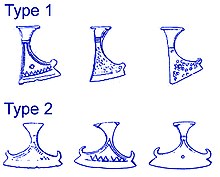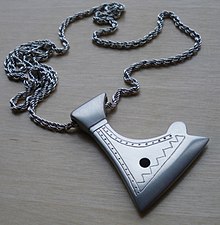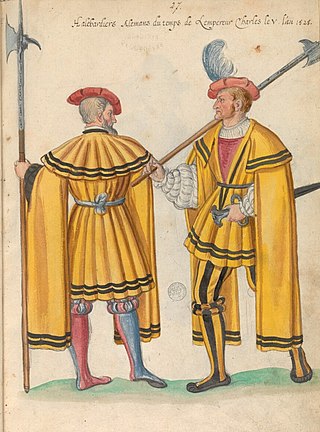
A halberd is a two-handed pole weapon that came to prominent use during the 13th, 14th, 15th, and 16th centuries. The halberd consists of an axe blade topped with a spike mounted on a long shaft. It can have a hook or thorn on the back side of the axe blade for grappling mounted combatants. The halberd was usually 1.5 to 1.8 metres long.
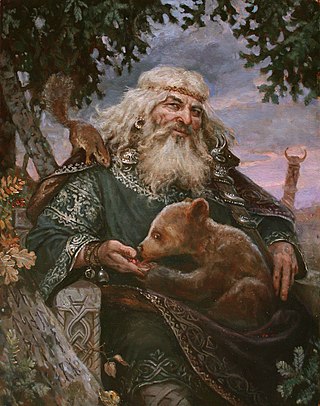
Veles, also known as Volos, is a major god of earth, waters, livestock, and the underworld in Slavic paganism. His mythology and powers are similar, though not identical, to those of Odin, Loki and Hermes.

Slavic mythology or Slavic religion is the religious beliefs, myths, and ritual practices of the Slavs before Christianisation, which occurred at various stages between the 8th and the 13th century. The South Slavs, who likely settled in the Balkan Peninsula during the 6th–7th centuries AD, bordering with the Byzantine Empire to the south, came under the sphere of influence of Eastern Christianity, beginning with the creation of writing systems for Slavic languages in 855 by the brothers Saints Cyril and Methodius and the adoption of Christianity in Bulgaria in 864 and 863 in Great Moravia. The East Slavs followed with the official adoption in 988 by Vladimir the Great of Kievan Rus'.

Mokosh is a Slavic goddess mentioned in the Primary Chronicle, protector of women's work and women's destiny. She watches over spinning and weaving, shearing of sheep, and protects women in childbirth. Mokosh is the Mother Goddess.

A bardiche, berdiche, bardische, bardeche, or berdish is a type of polearm used from the 14th to 17th centuries in Europe. Ultimately a descendant of the medieval sparth or Danish axe, the bardiche proper appears around 1400, but there are numerous medieval manuscripts that depict very similar weapons beginning c. 1250. The bardiche differs from the halberd in having neither a hook at the back nor a spear point at the top. The use of bardiches started in early 14th-century Austria. In the 16th century the bardiche became a weapon associated with the Russian streltsy.
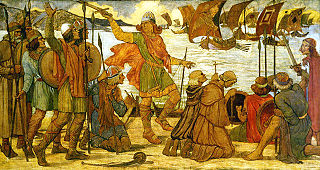
Knowledge about military technology of the Viking Age is based on relatively sparse archaeological finds, pictorial representation, and to some extent on the accounts in the Norse sagas and laws recorded in the 14th century.

The Zbruch Idol, Sviatovid is a 9th-century sculpture, more precisely an example of a bałwan, and one of the few monuments of pre-Christian Slavic beliefs. The pillar was commonly incorrectly associated with the Slavic deity Sviatovid, although current opinions on the exact meaning of all the bas-reliefs and their symbols differ. It is thought that the three tiers of bas-relief represent the three levels of the world, from the bottom underworld, to the middle mortal world and the uppermost, largest, world of heavenly gods.
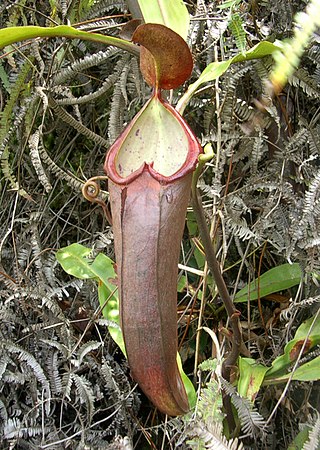
Nepenthes beccariana is a tropical pitcher plant. The species was described in 1908 by John Muirhead Macfarlane based on a specimen collected from the island of Nias, which lies off the western coast of Sumatra. It appears to be closely related to both N. longifolia and N. sumatrana, and the former is possibly a heterotypic synonym of this taxon.

The tradition of egg decoration in Slavic cultures originated in pagan times, and was transformed by the process of religious syncretism into the Christian Easter egg. Over time, many new techniques were added. Some versions of these decorated eggs have retained their pagan symbolism, while others have added Christian symbols and motifs.

Việt Khê is an archaeological site in the Red River Delta in northern Vietnam. Excavations there yielded a number of coffins containing relics of the Dong Son culture in Bronze Age. The Việt Khê construction site is located on the southern base of a hill which overlooks the Hàn River near Thủy Nguyên District, Haiphong. Five wooden coffins were excavated in 1961, each of which were aligned in the east-west direction, with at least two pairs of coffins being configured in a linear manner.

An axe is an implement that has been used for millennia to shape, split and cut wood, to harvest timber, as a weapon, and as a ceremonial or heraldic symbol. The axe has many forms and specialised uses but generally consists of an axe head with a handle, also called a haft or a helve.
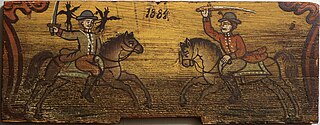
Kresnik is a Slavic god associated with fire, the summer solstice, and storms. His mythical home, a sacred mountain at the top of the world, represents the axis mundi.

In Slavic mythology, Perun is the highest god of the pantheon and the god of sky, thunder, lightning, storms, rain, law, war, fertility and oak trees. His other attributes were fire, mountains, wind, iris, eagle, firmament, horses and carts, and weapons. He was first associated with weapons made of stone and later with those of metal.

Many different weapons were created and used in Anglo-Saxon England between the fifth and eleventh centuries. Spears, used for piercing and throwing, were the most common weapon. Other commonplace weapons included the sword, axe, and knife—however, bows and arrows, as well as slings, were not frequently used by the Anglo-Saxons. For defensive purposes, the shield was the most common item used by warriors, although sometimes mail and helmets were used.

Nepenthes abgracilis is a tropical pitcher plant native to the Philippines. It is known only from northeastern Mindanao, including Mount Legaspi. Little is known about the altitudinal distribution of this species, but the holotype was collected at 670 m.

The tabar is a type of battle axe. The term tabar is used for axes originating from the Ottoman Empire, Persia, India and surrounding countries and cultures. As a loanword taken through Iranian Scythian, the word tabar is also used in most Slavic languages as the word for axe.
Slavic Native Faith (Rodnovery) has a theology that is generally monistic, consisting in the vision of a transcendental, supreme God which begets the universe and lives immanentised as the universe itself, present in decentralised and autonomous way in all its phenomena, generated by a multiplicity of deities which are independent hypostases, facets, particles or energies of the consciousness and will of the supreme God itself.
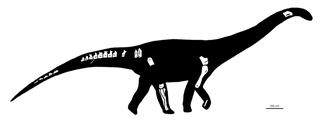
Nullotitan is a genus of lithostrotian titanosaur from the Chorrillo Formation from Santa Cruz Province in Argentina. The type and only species is Nullotitan glaciaris. It was a contemporary of the ornithopod Isasicursor which was described in the same paper.
Interpretatio slavica is the practice by the Slavic peoples to identify the gods of neighboring peoples and the names of Christian saints with the names of Slavic deities.
Phorcys is an extinct genus of gorgonopsian that lived during the Middle Permian period (Guadalupian) of what is now South Africa. It is known from two specimens, both portions from the back of the skull, that were described and named in 2022 as a new genus and species P. dubei by Christian Kammerer and Bruce Rubidge. The generic name is from Phorcys of Greek mythology, the father of the Gorgons from which the gorgonopsians are named after, and refers to its status as one of the oldest representatives of the group in the fossil record. Phorcys was recovered from the lowest strata of the Tapinocephalus Assemblage Zone (AZ) of the Beaufort Group, making it one of the oldest known gorgonopsians in the fossil record—second only to fragmentary remains of an indeterminate gorgonopsian from the older underlying Eodicynodon Assemblage Zone.
